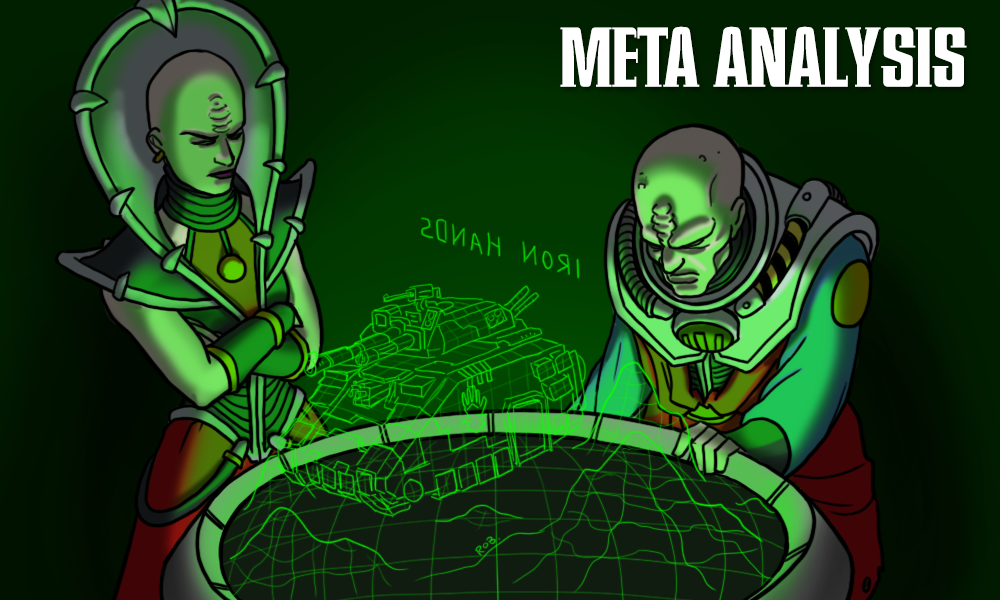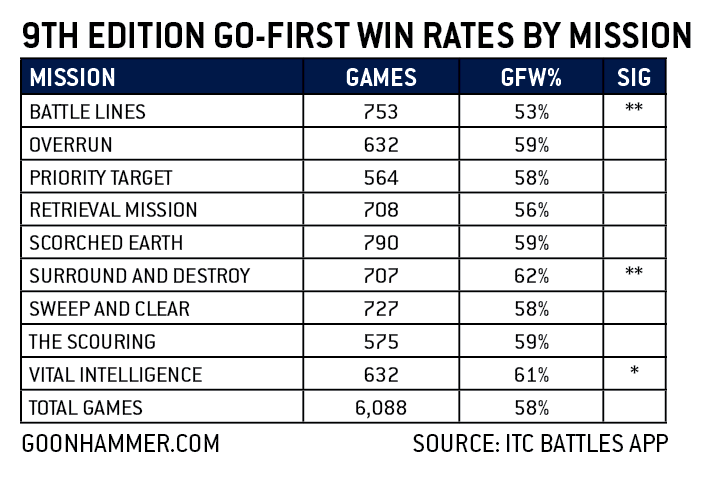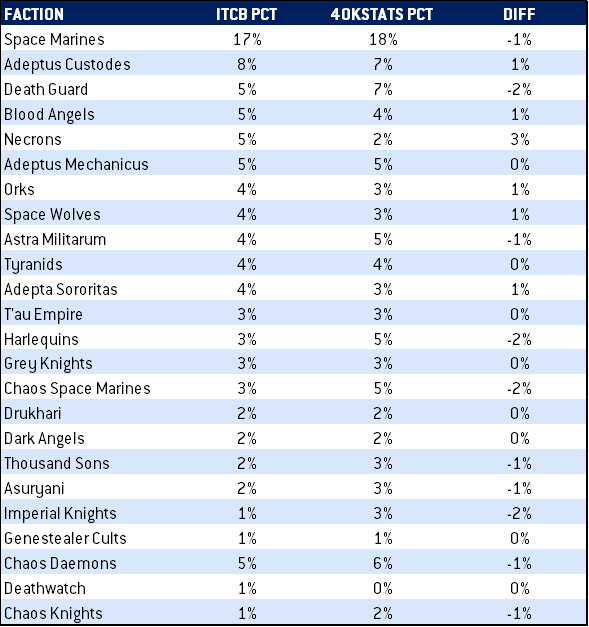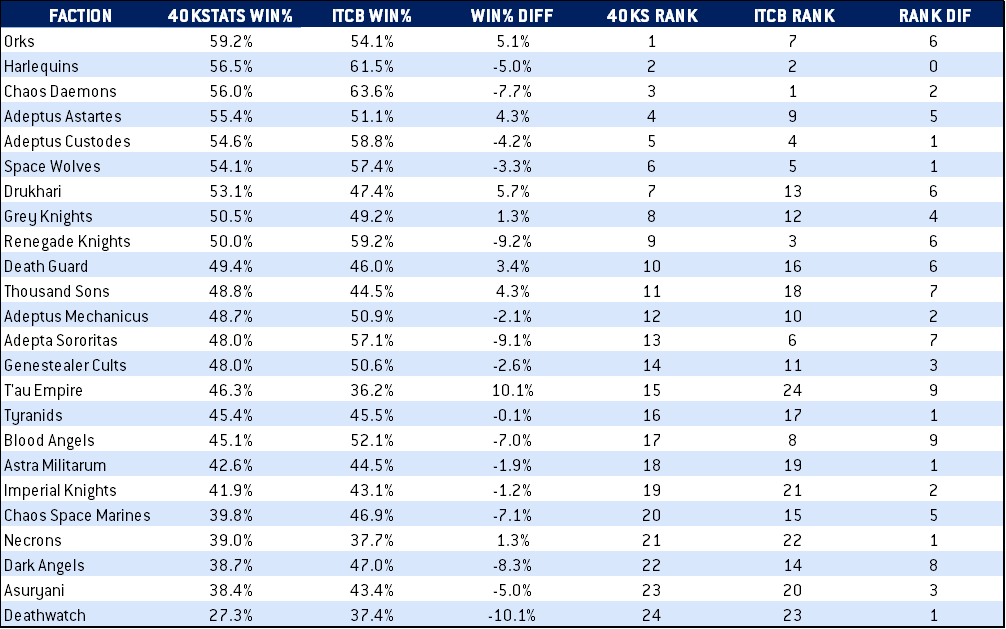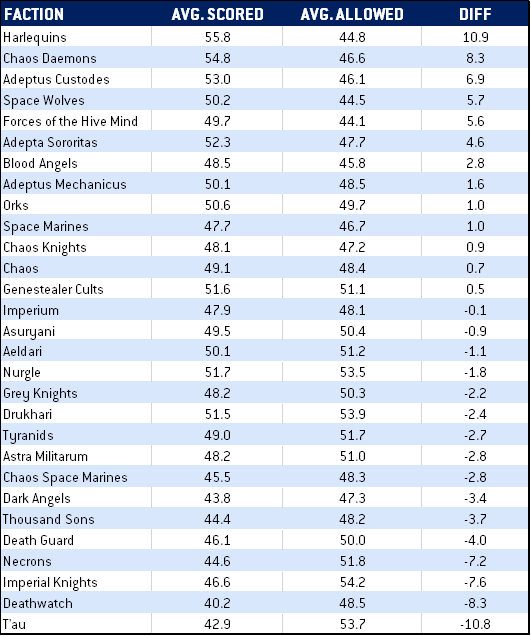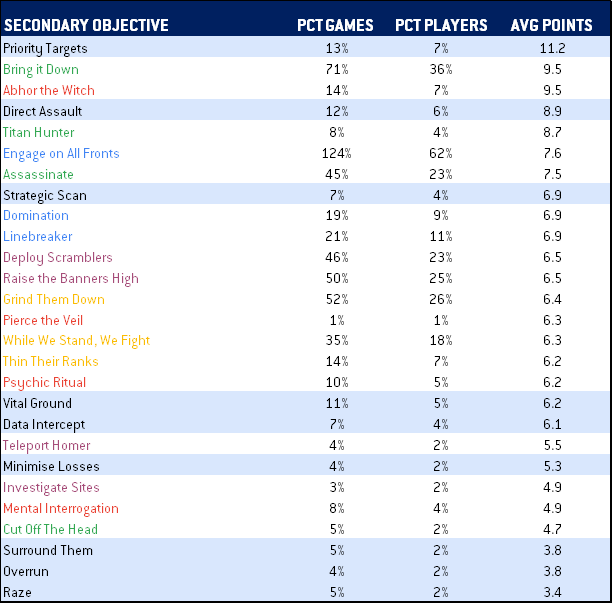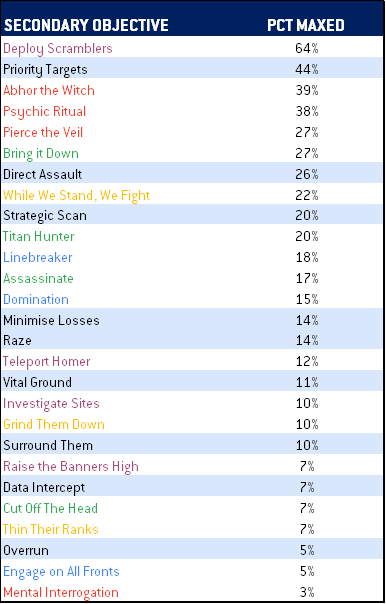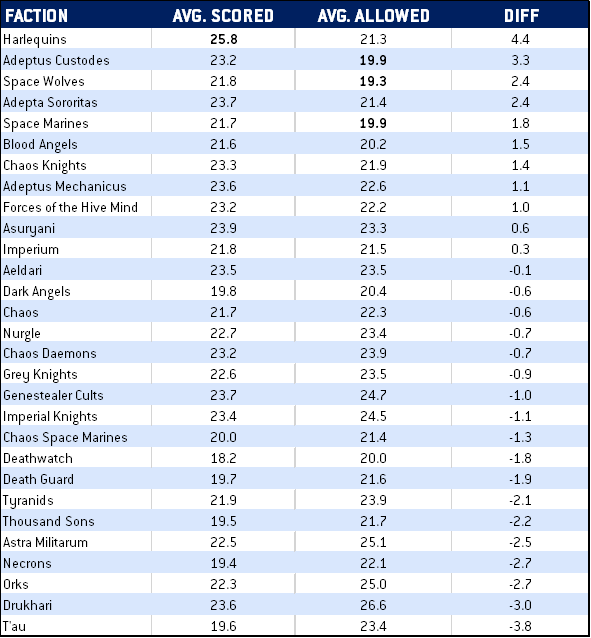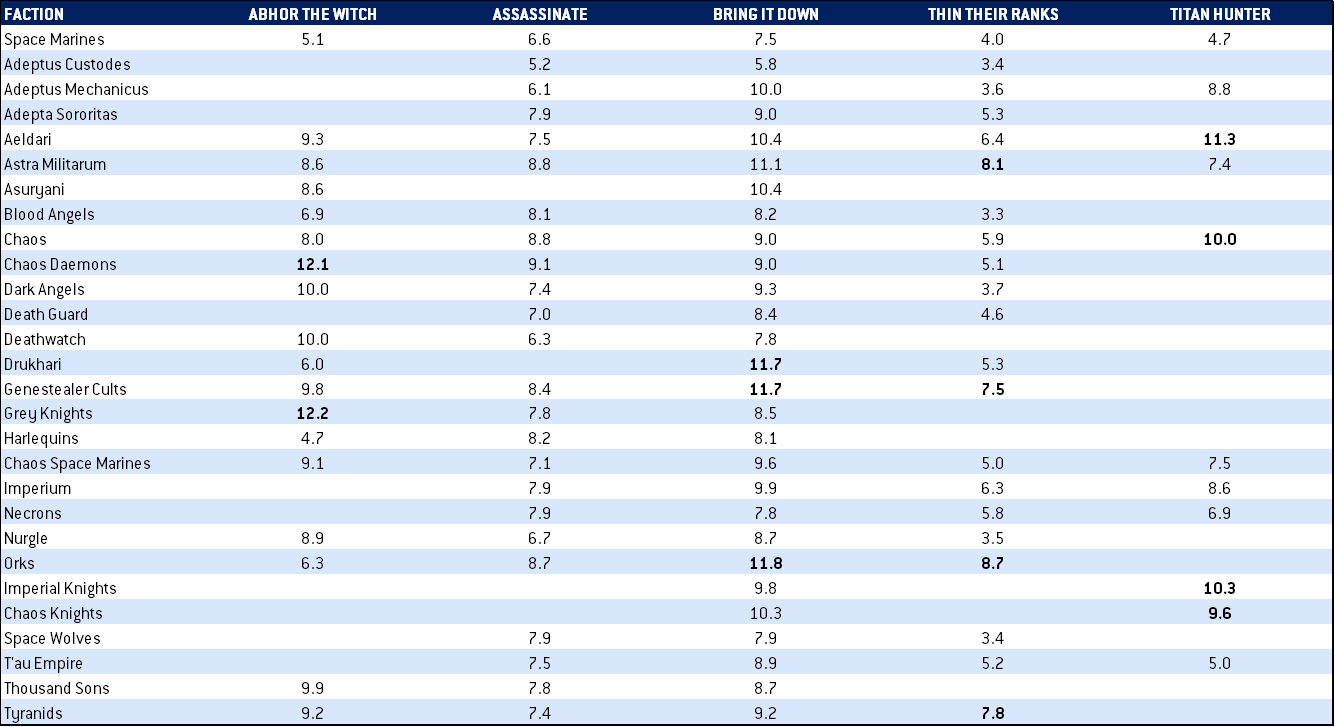We’re now a full two months into 40k’s 9th edition and contrary to our initial notions that the meta might have settled by now, it seems that the field is still in flux as players explore new builds for armies and our initial ideas about what would be good and bad in 9th edition are thrown into stark relief against the practical reality.
While we’re anxiously waiting for the next major release to completely shake up the meta – Codex Space Marines and Necrons are now only a week away – it made sense to sit down and look at the current meta, how things are shaking out as we prepare to enter what looks like another long codex release cycle, and revisit some of our assumptions and analysis from last month.
Table of Contents
The Dataset
Let’s start with the data. This analysis is only possible because of some great work done by a lot of great people in the community, at events and at sites that specialize in collecting this data.
Events Data
We’ve collected events from TOs globally showcasing round-by-round win results, including first turn win rates, in order to look at the impact of taking the first turn on win rates in each round of a tournament. Our sample of events includes:
- NEW – Iron Halo – 109 Players / 6 Rounds
- Flying Monkey – 74 Players / 6 Rounds
- Wizard Asylum GT – 32 Players / 5 Rounds
- Battle for Survival – 24 Players / 5 Rounds
- NEW – Varbergs 2020 GT – 24 Players / 5 Rounds
ITC Battles App Data
After our last article, the wonderful folks behind the excellent ITC Battles app reached out to us and sent us the full ITC battles dataset for 9th edition. The app, used to help players track their scores and stats in games of 40k, tracks ITC faction, secondaries selected, points scored, CP usage, and which player had the first turn. ITC Battles app data includes a mix of tournament/event games and non-tournament games, but overall gives us data on 6,088 player-reported games of 9th edition, of which 1,093 took place at tournaments or events. That’s a fantastic amount of data, and allows us to really dig into some of the nuances, plus helps us be certain that our observed results are statistically significant.
If you haven’t used the ITC Battles app, it’s worth checking out – you can find the app on the Apple or Google Play app stores or visit their website here.
40kstats
We also refer often to 40kstats.com, which is a fantastic resource for seeing top lists and getting a quick picture of the meta. 40kstats provides downloadable data on lists from the events they track, and collects data on subfactions that isn’t represented in the ITC Battles app dataset. They’ve also helpfully compiled data for GT events in 9th edition, and have their own proprietary metric for gauging the tournament strength of an army, Tournaments In Winning Position (TiWP).
The First Turn Problem
Last month, we wrote about the potential advantage of going first in 9th edition Warhammer 40k and concluded that, while we needed more data to verify, the player going first winning 57.9% of the time (with higher win rates for later rounds of a tournament) was a significant issue.
With a larger sample size of data (6,088 games) from the ITC Battles app, we can now say with much more confidence that, yes, going first represents a significant advantage in 9th edition.
 Last time our sample was around 340 games. Now we’re at more than six thousand, and of those more than one thousand have been logged as tournament games. The results are even more pronounced here – our prior analysis pegged the go-first win rate at 57.9% on the whole, and this new data suggests that was pretty close, if even a bit conservative. By any reasonable measure, this is a statistically significant difference from the supposed ideal win rate of 50% for players going first.
Last time our sample was around 340 games. Now we’re at more than six thousand, and of those more than one thousand have been logged as tournament games. The results are even more pronounced here – our prior analysis pegged the go-first win rate at 57.9% on the whole, and this new data suggests that was pretty close, if even a bit conservative. By any reasonable measure, this is a statistically significant difference from the supposed ideal win rate of 50% for players going first.
But how do these win rates stack up to 8th edition? Something we’ve debated internally is whether this represents a significant change from the prior edition, particularly when compared to the changes brought by the 2020 ITC tournament pack that was unveiled following the Las Vegas Open. We’d already heard from several great players, including Richard Siegler, that they’d choose to go second. So How did things look in 8th? Do things just feel really off or is there an actual difference?
Well, turns out that while 8th edition games did confer a slight advantage for going first, it wasn’t nearly as pronounced, with the player going first winning about 54% of the time and that effect potentially being depressed at higher levels of tournament play, where better tactics could potentially mitigate the impacts of an alpha strike.
“But how did the ITC 2020 changes to deployment and seize affect go-first win rates?” you ask, demanding an even deeper level of data analysis. Well, I went ahead and looked at that too – turns out the ITC 2020 season rules changes did have a positive impact on go-first win rates, further lowering them to sub-53% (though note that this change is itself, not statistically significant). This is still a statistically significant advantage for going first overall, but it’s much closer to that ideal 50% mark. Pretty good!
 First Turn Wins and Mission
First Turn Wins and Mission
Something we looked at last time we did our analysis was the impact of the mission on go-first win rates, but we didn’t have near enough data to perform a meaningful analysis. With the larger dataset from ITC Battles, we can revisit that analysis and look at how different missions may have larger or smaller go-first win rates.
Now we’re talking. On the whole, most of these aren’t significantly different from the baseline 58% go-first win rate for 9th edition overall, but we have two notable outliers, where there is a significant difference – Battle Lines, which has a 53% go-first win rate, and Surround and Destroy, which sees the player with first turn winning 62% of the time. At a lower confidence level we have Vital Intelligence, which also sees elevated go-first win rates. You may recall that the Iron Halo GT had Vital Intelligence as its round 6 mission, and the go-first win rates we saw there lined up pretty closely with this result.
The immediate advice here if you’re a Tournament Organizer selecting missions is: “Choose Battle Lines, avoid Surround and Destroy and Vital Intelligence.” But what is it about these missions that causes their go-first win rates to skew so heavily? We compiled a list of potential causes, and then performed a series of regression analyses to identify the relationship between those variables and the variation in go-first win rates. For this we looked at:
- The number of objective markers in each mission (4 to 6)
- Whether the mission used Take & Hold (hold 1/2/more) or Domination (hold 2/3/more) for primary scoring
- The average distance, in inches, from objectives in the mission to the center of the battlefield – larger distances indicate more spread out objectives
- The number of objectives in each player’s deployment zone
- Whether the mission’s custom secondary objective was Endgame or Progressive
- The average number of secondary points scored by players from the mission’s custom secondary objective
- Whether the mission had an objective marker in the center of the battlefield
Of these, only the total number of objective markers on the mission had significant explanatory power, with the number of objectives explaining about fifty percent of the difference in go-first win rates for missions (r-square value = .502). This makes sense, given that Battle Lines is the only mission with four objective markers, and that the 6-marker missions tend to have higher go-first win rates.
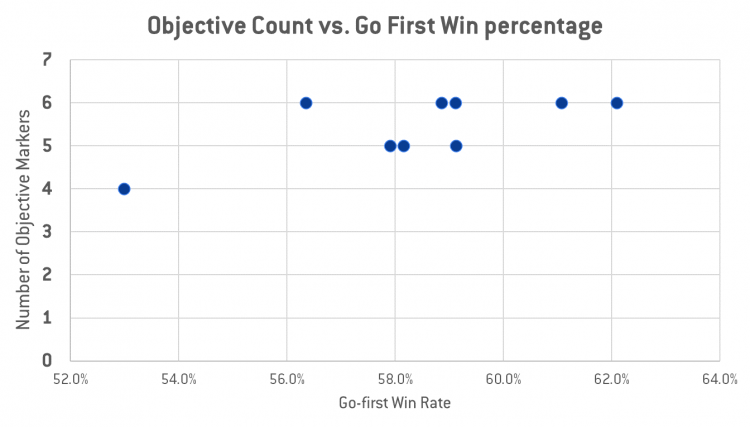 So while the number of objectives is likely a key part of the story, there are clearly other factors at play in these missions.
So while the number of objectives is likely a key part of the story, there are clearly other factors at play in these missions.
Wings: This is really interesting stuff, and it’s interesting to consider how the three missions showing the most profound effect get there.
Battle Lines beats the spread considerably, appearing to be the most balanced mission in direct contradiction of what I expected going into the edition. WIth two months of seeing how the game now plays behind us, that starts to make sense. My early assumption was that only having four objectives would favour the player going first, as they could move onto both of them and put the opponent on the back foot straight away. However, it turns out it doesn’t quite work that way. With both mid-board objectives on the centre line, committing forces to either of them puts you well in range of a counterattack by player two. If player two launches that counterattack and pushes you off the objective, then you only get 5VP in your second turn.
The direct comparison to this is Retrieval mission, where there are four objectives in no-man’s land. In that mission, it’s more likely that player 2 will have “free” objectives to move on to in their first turn, but less likely that they’ll be able to reach out and stop player 1 locking in at least 10 VP out of the gate, especially if they’re relying on melee tools. With attrition favouring player 1, and the last touch on impacting primary scoring, starting with a very reliable 10VP favours them a lot.
That follows through into why Surround and Destroy favours player 1 so much. With two extremely safe home objectives, player 1 can focus on contesting the mid-board turn one, and even if they’re immediately repulsed they almost certainly get 10VP as a consolation prize from their two home objectives, allowing them to focus on grinding their opponent out of the game.
VItal Intelligence, on the other hand, has the issue that you have to build a foothold in the mid-board to score at all. With two sets of two clustered objectives, here player one can focus on going hard for one of these and running interference on their opponent’s attempts to do the same to the other set. WIth scoring just being hard in this mission, player 1 can use their first move advantage to set up a position, then lean on their likely attrition advantage to cruise to victory.
Go-First Wins by Faction
We’ve looked at the impact of mission, now it’s time to examine the other side of the coin – are some factions better at winning with the first turn than others, and are there factions that perform better going second?
Go-First Win Rates by Player Faction
| Faction | Total Games | Go-First Win Rate | Go-Second Win Rate | Diff |
|---|---|---|---|---|
| Chaos Daemons | 83 | 72% | 55% | 17% |
| Adeptus Custodes | 790 | 68% | 47% | 21% |
| Orks | 461 | 67% | 42% | 25% |
| Adepta Sororitas | 403 | 67% | 49% | 17% |
| Harlequins | 313 | 64% | 59% | 5% |
| Grey Knights | 321 | 63% | 39% | 24% |
| Space Wolves | 437 | 63% | 56% | 7% |
| Chaos | 474 | 61% | 43% | 19% |
| Blood Angels | 525 | 60% | 42% | 18% |
| Adeptus Astartes | 1,804 | 59% | 44% | 15% |
| Drukhari | 266 | 59% | 36% | 23% |
| Adeptus Mechanicus | 462 | 59% | 40% | 18% |
| Grand Total | 12,176 | 58% | 42% | 17% |
| Imperium | 200 | 58% | 47% | 11% |
| Dark Angels | 239 | 57% | 38% | 19% |
| Nurgle | 108 | 57% | 39% | 18% |
| Chaos Space Marines | 276 | 55% | 38% | 18% |
| Thousand Sons | 176 | 55% | 34% | 21% |
| Aeldari | 350 | 54% | 49% | 6% |
| Astra Militarum | 405 | 54% | 29% | 25% |
| Asuryani | 191 | 53% | 39% | 14% |
| Imperial Knights | 136 | 52% | 31% | 21% |
| Tyranids | 382 | 52% | 35% | 17% |
| Death Guard | 592 | 51% | 37% | 14% |
| Genestealer Cults | 108 | 50% | 46% | 4% |
| T'au Empire | 361 | 49% | 24% | 25% |
| Deathwatch | 83 | 49% | 33% | 15% |
| Necrons | 502 | 40% | 36% | 4% |
So there’s one major caveat here – ITC Battles app data doesn’t break out Space Marine subfactions, so unfortunately, we don’t have a great look into how those factions fare individually, but since they all have access to Infiltrators, we can at least hypothesize that while some subfactions are likely winning more games, they may not be skewing the go-first win percentage.
Some key things to note here: No faction in 40k has a higher win rate going second. The closest factions are Harlequins (+5%), Space Wolves (+4%), Aeldari (+6%), Genestealer Cults (+4%), and Necrons (+4%). For the latter three, this isn’t so much an endorsement of their ability to win going second as it is a reminder that their win rates are low enough that it doesn’t seem to matter much.
The second thing to note is that the factions that have the highest win rates going second tend to just be the factions with the highest win rates. There’s a significant strong positive correlation (r=.64) between go-first and go-second win rates. Strong factions are just going to win more games overall.
That said, there were some stand-out items here, with factions that tended to have a wide gulf between their go-first and go-second win rates. Both Adeptus Custodes and Orks seem to be big beneficiaries of going first, with nigh-unbeatable win rates when they do have the first turn and being merely average when they don’t. Grey Knights and Drukhari had similar challenges.
The worst off of the 40k factions (T’au, Deathwatch, Necrons) average a sub-50% win rate even with first turn advantage, and T’au have a massive disparity on top of that, giving them a 24% win rate going second. The good news is that we’re about to get new Deathwatch and Necrons codexes that should help those factions out. The bad news is, well, everything about the T’au situation.
The Impact by Round
Something else we discussed in our September analysis was the impact of first turn advantage and how it changed throughout a tournament. To recap, our theory is: Good players will be better at overcoming the inherent disadvantages of going second, particularly when they’re matched against bad players. In the first round of tournaments, pairings are random, meaning that good players will often be paired against players of lower skill, and be in a good position to overcome going second. As a tournament progresses however, players are matched according to their records and points scored, so as an event goes on, each round should see players who are progressively closer in skill being paired up. As player skill becomes more even, the advantage of going first should become more pronounced. This was certainly the case the last time we looked at our events data, but did it still hold true?
Boon: First, big thank you to Jason Horn and his dedicated man-servant Logan for their dedication in bringing us this data. The last time we took a look we noted some very stark differences in go-first win rates for day one vs day two of GT-level play. Specifically, in the 340 games we recorded for go-first-wins, we noted a significant trend in rounds 1-3 of underperforming the average go-first-win rate, to the tune of 54.5% on day one vs the average of 58%. As we moved into rounds 4, 5, and potentially 6 on day two – we noted the sharp increase to 62.4% – proving significant and justifying our conclusion.
With Iron Halo we nearly doubled our recorded GT+ level games – adding 308 defined W/L games and then a further 53 games from the Varbergs 2020 GT and the results are a bit of a mixed bag. At Iron Halo we observed the following:
Event Total: 308 games, GFW%: 56.5%
Day One: 162 games, GFW%: 56.2%
- Round One (Scorched Earth): 54 games, 57.41%
- Round Two (Battlelines): 54 games, 55.6%
- Round Three (Sweep and Clear): 54 games, 55.6%
Day Two: 146 games, GFW%: 56.9%
- Round Four (Priority Target): 53 games, 54.7%
- Round Five (The Scouring): 49 games, 55.1%
- Round Six (Vital Intelligence): 44 games, 61.4%
The much smaller Varbergs 2020 GT, while an outlier in terms of GFW% at 45.3% overall in 53 games, did show a strong day one vs day two breakout at 40.6% and 52.4%, respectively. However, we acknowledge that this lone event has too few games in its day one vs day two splits to be considered for this analysis.
Rob’s Note: Additionally, the higher go-first win rate for round six is likely due to the Vital Intelligence mission. We’ll talk more about that below but this is something we can verify in the future with more data.
So it begs the question as to why our consolidated data from our previous three GT+ events, and a comparable data set from Iron Halo tell two different stories. There are a few possibilities here:
- Player skill has shifted to better accommodate going second
- Iron Halo is an outlier
- The missions being played have a larger impact on go-first win rates than pairings
- The theory is wrong
It’s possible, perhaps even likely, that there are more than one of these at play – but for simplicity’s sake, let’s assume they’re mutually exclusive.
Player Skill
Our prior data encompasses events all observed within a month of the launch of 9th edition. As with any new ruleset, there is a period of shakeout as players learn to adjust to the new dynamics of the game. As the impact of the go-first advantage becomes known, it’s reasonable to conclude that the less experienced players have more acutely accounted for it in their faction selection, list selection, and tactics employed at the table. This is a compelling argument but I’m not clear that it holds significant explanatory value – one would presume that the impact of building and playing to go second would have an effect on universally on the GFW rates and depress the overall results. However, the overall win rate is not significantly different from our overall average.
The Mission Impact
This is a hard one to evaluate. Round 6 of Iron Halo stands out as consistent with our mission data, but if this was explanatory we’d expect to see this repeated across the other events in our prior analysis. However, I note that in our analysis of the Wizard Asylum event we saw a round two Vital Intelligence mission result in a 40% GFW rate, and conversely, a 70+% GFW rate on a round four Battle Lines. However, with Flying Monkey, we note that both Surround & Destroy and Vital Intelligence played in rounds two and three respectively led to larger than expected GFW rates, while Battle Lines in round 4 led to a lower than expected win rate. Given our volume of data on the missions, I am certain there is an impact here, but it’s not clear to me that the strength of that impact is sufficient to explain what we have seen overall and within Iron Halo or that it is the most impactful variable. Unfortunately, if TOs take our advice, we may also see a decline in the use of either Surround & Destroy and Vital Intelligence which will hinder our ability to track.
An Outlier
Iron Halo is a singular event/data point. The faction mix, the player mix, and the terrain setups are all unique – it’s possible that one or more of the variables drive a more level-setting of performance across the rounds. A couple of items that in particular stand out to me are the:
- Faction Mix
- Terrain Setup
The factions at Iron Halo were heavily Imperium at near 68%, moreover, the lion’s share consisted of Space Marine factions which have slightly smaller than average disparity between GFW and GSW rates. Unfortunately we don’t have the sub-faction splits, but a large percentage of the Iron Halo field was composed of Salamanders which I theorize have a smaller disparity between GFW and GSW than the average for Adpetus Astartes due to their increased overall win percentage and my perception on their playstyle utilizing more strat reserved units than average.
The terrain itself was heavier than at Flying Monkey or Wizard Asylum, as all ruin pieces, regardless of the 5” height were considered to Obscure – ruins were by far the most prevalent terrain piece of the Iron Halo boards and a fair many of them naturally blocked LOS despite the Obscuring. This may have also played into the leveling across the rounds and a slightly lower (but not significant) GFW for the event.
The Theory Fails
The final possibility is that our theory of a strong day one vs day two difference may simply be wrong. And frankly, that’s perfectly fine – we draw conclusions based on the evidence in front of us, and when that evidence changes so must our understanding. At this point it’s hard to say that it’s wrong as the difference in day one and day two, even with the Iron Halo data, is notable.
Ultimately, there are likely to be a wide mix of factors at play and I won’t discount that with more data we may be wrong on a day one vs day two trend. We will continue to test it with each new dataset we get – we’ll look to continue to evaluate this into the future as we look ahead to Renegade and Mid-MO Maelstrom.
The Meta Results
Our own inestimable One_Wing has been doing a fantastic job covering the cutting edge lists of the 9th edition tournament scene, taking a microscope to the top 4 lists of major events and talking about how we see faction tiers in 9th edition. Some of that was based on the data we’ve been compiling here, and so here we’re going to take another look and go even deeper into the stats behind faction performance, both in the ITC Battles app and with 40kstats’ events data.
There are two things to note here about the ITC Battles app data: The first is that it doesn’t break out Space Marines/Adeptus Astartes armies by subfaction. This is unfortunate, since we’re pretty sure there’s a wide gulf of strength between the top marine chapters and the bottom ones (more on that in a bit). The second thing is that ITC Battles app data represents a much larger group of players and events (such as leagues and RTTs), and as a result will include weaker lists and players overall, but also a wider variety of potential lists, since it’ll include test games where players are trying things that wouldn’t necessarily make it to a GT.
The good news is, we can look at both sets of data, and get a picture of both the broad meta as it’s likely to be experienced by average players on a day-to-day basis, and also the GT-driven upper-level meta. Let’s start with faction counts:
A Breakdown of Competitive Factions
We can generally see how the ITC Battles factions data broadens things a bit, with fewer marines, Death Guard, Harlequins, and Chaos lists in favor of more Orks, Space Wolves, Necrons, Custodes, and Blood Angels, but overall these two datasets are pretty close, and currently it looks like Codex: Space Marines, while still a powerful force and the most common faction in the meta, make up about 18% of lists. That’s a far cry from the 27% we saw at LVO 2020.
Using 40kstats data, we can dive into the marine chapters and how they might be contributing to marines’ overall scores. Non-codex chapters have been included on the chart below, although they aren’t included in the “Codex Space Marines” average.
So with that bit of context in place, let’s look at the win percentages for each faction to see what that can tell us about the relative power of 9th edition factions.
Win Rate by Faction, 9th Edition 40k (October 2020)
In some ways, we can think of 40kstats’ GT data as the “Playoffs” data to the ITC Battles app’s “Regular Season” data, where the former has a smaller sample size and higher quality play and the latter has a much broader range of play styles and a much larger sample size. However it’s clear that ITC Battles app win percentages are highly predictive of GT success, and the two are highly correlated (r=0.73). There are likely other factors that explain the remaining discrepancies, but on the whole the two datasets are closely related, and paint a picture that sees Orks, Harlequins, Custodes, Daemons, and Marines – particularly Salamanders, Space Wolves, and White Scars – at the top of the groupings when it comes to winning games.
If this looks like our recent tier analysis from One_Wing well, that’s no accident – we had access to much of this data when that was being written, and while some factors outside of pure win rate shifted a few factions up and down, this dataset was used to cross-check many of the conclusions .
Head-to-Head Faction Results
Drunk with power on our new large dataset, we started looking at the possibilities of doing more detailed splits with our data and one of the ones that immediately came to mind was looking at head-to-head results for the factions in the sample. Removing matchups and factions with insufficient data, we’re left with the following:
Head-to-Head Faction Win Rates, October 2020 (Source: ITC Battles app)
Read left to right, i.e. Marines beat Custodes 43% of the time
There’s a lot going on in this chart. It’s useful data, but it’s too much to display as a table. It’s interesting to look at individual match-ups on here to see who may have the upper hand where, but ultimately this is a step toward another way of considering our tier structure. Specifically, we can look at factions according to the number of favorable match-ups they have by win-rate. If we define a “favorable” match-up as win percentages of 55%+ and unfavorable as 45% and under, then we can count the number of favorable/unfavorable matchups for each faction and use that to tell the story of that faction’s power while also helping us better understand why a faction might struggle to win certain events.
So here we end up with a tier system that looks similar to the ones we’ve already put out, but with some interesting quirks. First, we have to acknowledge that while Marines are low here in terms of relative number of favorable matchups, they also vary wildly in power (as we’ve seen above), and will also generally have a neutral matchup for the mirror match, and marines are the most common faction.
So with so many favorable match-ups and a high win rate, why aren’t Custodes winning more events? Similarly, why aren’t Sisters of Battle closing things out more often?
Boon: As Rob mentions, the Custodes in particular are a common sight at GT+ level events – according to 40kstats they’ve logged more high-level play games than any other faction at 280 games. Despite their ubiquitousness they haven’t quite accomplished as much as their representation and win percentages would suggest – winning two events, placing highly in two others, and holding the lowest Tournaments in Winning Position ratios amongst the winning factions by a wide margin (a 40kstats metric measuring lists that enter into the final rounds at 4-0 and thus in place to win). And while tippy-top placings may not be the only metric of tournament success, it certainly speaks to the ability to:
- Win games
- Win games with large VP differentials (place highly)
I think the reasons for this aren’t as simple or straight forward as we might expect. First, Custodes are a low model and unit count army – this is obvious. They benefit mightily from their durability and objective secured advantages in the 9th edition mission sets. They want to force you into playing their game; dare you to come close and shift them from objectives, force you onto the backfoot, and prevent you from maneuvering to focus down pieces of their army – this is partially reflected in their go-first/go-second differential – on the backfoot the Custodes may be more easily outmaneuvered and attrition can be a huge detriment in missions sets that forces them to cover a lot of ground with a limited set of units.
I think this nuance in the Custodes play style lends itself to a much larger issue that I believe also affects Space Marines generally. They are an exceptionally easy army to play, but a much harder army to play well. What I mean is that the basic concept of the army is very straightforward – the army is forgiving to mistakes, hard to pick secondaries against, and the decision options available to a player in a given turn are more limited than armies which require more interactions and moving parts to be effective. It’s an easy army to jump into, learn, and do well with. Unfortunately, it’s also limited in its flexibility and the fact that the army will face a much higher rate of armies prepared to deal with them specifically means that it becomes difficult to reach that upper tier at a GT. And therein lies the crux of it. Despite the Custodes natural advantages and favorable faction matchups, they are often hard-countered by a disparity in player skill after a few rounds of GT-play or the eventuality of running into a list that is prepared to face them – when you’re king everyone is gunning for you. The truly skilled Custodes players will fare fine as they can adjust at the table, but most Custodes players just won’t get to that point which ultimately depresses their numbers. In my mind, they’re a true gatekeeper faction.
Wings: Sisters are the perfect example of a faction where the win rate data doesn’t tell the full story, because they’re an odd mix of being extremely potent against unprepared opponents pretty much whoever is playing them, but having a high skill ceiling to get the most out of them at the top tables.
Until you’ve actually played a game on the table against a good Sisters player, it’s really hard to get a feel for just how much Acts of Faith change the dynamics of the game where their melee units are involved, and with those units (most notably Repentia) being absurdly deadly for their price, opponents who don’t treat them with appropriate caution are going to be bowled over and get forced into incredibly one-sided trades. Combine that with Sisters being basically good at playing the 9th missions, and you have an army that will comfortably rack up wins against less experienced players (and I think it’s notable here that Sisters have one of the largest overformances in the ITCB data rather than 40K stats).
However, as a melee-focused army relying on movement tricks and glass cannon killers there’s plenty of angles for opponents familiar with its capabilities to push back against it, and I suspect that the drive behind the effects we’re seeing is that plenty of Sisters players are running into a brick wall around the 2-0 bracket, slamming face first into top-end players who know exactly how to take their plan apart and thus not being able to follow through to a podium finish.
That’s not to say Sisters don’t have the power to win events – they absolutely do (which we saw last weekend at the Red Rock GT) and I stand by my tier 2 rating for them. The skill ceiling for the army is just very high. The army has an extra resource pool to manage, relies on careful positioning of auras to keep the units operating at maximum, and setting up the peak movement nonsense they can pull off requires careful forward planning. Being heavily melee focused also makes them unforgiving – you don’t have the safety blanket of something like a Grav Pod to neutralise your opponent’s most dangerous threat out of the gate, so you’re usually going to be playing into the teeth of a fully operational army in the early turns
Players who’ve dedicated time and practice to really mastering the army are going to be able to push through these challenges to victory, but on the way to that level of mastery they’re going to cap out at 3-2 plenty of times, pushing the faction’s win rate up without the expected density of podium finishes to show for it.
Victory Points and Winning Games
So we’ve got a good understanding of the way factions shake out in terms of win percentage and match-ups; now let’s talk about what winning games looks like and dig into those factions and how they win games to understand what’s causing the discrepancies in win percentage.
We talked about this last time, but generally speaking, wins tend to occur when a player scores 80+ victory points – at that number you have better than an 80% chance of winning.
We’ll revisit what this means for you, the player in a bit. In practical terms for factions, this means that winning is going to be about scoring 80+ points and not giving up 80+. So let’s take a look at results by faction to see if we can identify why those factions might be performing as they are.
Victory Points Scored by Faction
OK, roughly the same story, but a different dataset. Here we can see some interesting things. The first is that there are a few factions that score more points and give up more – Genestealer Cults stand out here in particular as a faction that scores relatively high but gives up too many points, and likewise with Drukhari. Meanwhile the Blood Angels are lower-scoring but also allow fewer points than any other faction, on average.
With the new mission structure of 9th, there’s much more to dig into here. Let’s talk about the road to 80+ points.
Scoring Primary Objectives
Let’s start with primary objectives, then. I’m going to risk not showing off another full factions chart here because we’ve already gotten heavy on the large tables with every faction. Suffice it to say, the primary objective data, while useful, is less interesting than the secondary data, so we’ll focus quickly on who does well at scoring primary objectives:
Top 5 Factions by Primary Scoring, October 2020 (Source: ITC Battles app)
Daemons are no shock here, thanks to being generally mobile and well, Nurglings. Same goes for Harlequins, who may be the most mobile army in the game. Custodes are very good at holding objectives once they’re on them, and SIsters can be absurdly deadly melee combatants as Wings mentioned. Nurgle-specific armies are interesting here, as they tend to give up more primary points than they score, despite having a high average primary score. That’s an area where a lack of mobility may hurt them, despite an ability to be on objectives early
Marines and Orks fell just outside of this, with Space Wolves having the best showing (some of this may be due to ObSec everything for a time). On the other hand the bottom five shows us that knights and T’au are really bad at capturing and holding objectives. Thousand Sons fell just outside this bottom five, and they’re likely in the same boat as Deathwatch as “an elite army that isn’t all that durable.”
Bottom 5 Factions by Primary Scoring, October 2020 (Source: ITC Battles app)
Here’s the thing: The good factions win more games, so they have to be good at both scoring primaries and secondaries, and the bad factions have to be bad at both. So what we really want to look at is that differential – who’s scoring more while giving up more, vs. who’s scoring blowouts. I went ahead and sorted the results by points differential and while most of these weren’t a shock, Drukhari, Genestealer Cults, and Tyranids suddenly rocketing into the top 6 was interesting.
Top 5 Factions by Primary Scoring Differential, October 2020 (Source: ITC Battles app)
First off, it seems like Daemons and Harlequins do amazingly well at scoring primary objectives and preventing opponents from taking theirs. We’ll also see that they do well at secondary objectives. Forces of the Hive Mind, not so much – though note that this is driven primarily by Genestealer Cultists, who fell just outside of our top 5 while Tyranids fell much lower in primary scoring differential. Orks and Custodes aren’t a huge surprise here. Otherwise, Nurgle are our biggest other surprise as a faction whose differential is negative despite a high primary score.
Mission Impacts on Primary Scoring
We’ve talked about mission impacts on go-first win rates and seen some effects there, but how do missions affect primary scoring? Well, the big one is that Domination appears to depress primary scoring. This isn’t a huge surprise, but on average, primary scoring for Domination missions (where players have to hold two / three objectives to score points as opposed to one / two in take and hold missions) is about 11 points lower on average, particularly on The Scouring, which combines Domination with a smaller number of objective markers (5).
Primary Scoring by Mission, October 2020 (Source: ITC Battles app)
There’s potentially more to dig into here, looking at how factions do on different mission layouts, but we’ve already ballooned the scope of this out pretty massively and so that particular analysis will have to wait for another day. While we’re on the topic, our distribution of missions in the ITC Battle app sample was pretty uniform, with no mission having more than a 12% share of games played nor lower than 9%.
Secondary Scoring
Let’s talk about secondary objectives. The first thing we want to do is look at the number of times secondaries are picked, and the average points scored. This will give us a pretty clear idea of which secondaries are generally good and which ones are likely to be “trap” choices, and help us understand how this might impact army construction in 9th edition.
Secondary Selections and Average Points Scored, October 2020 (Source: ITC Battles app)
Percentage of games based on the number of games where the secondary choice was possible. Note that each secondary could be chosen twice per game.
So a few immediate things here:
- Priority Targets is really good. While on the whole, mission secondaries tended to be really bad if not downright awful, Priority Targets consistently results in the most points scored per game of any secondary. If you’re playing Priority Target, you should consider taking this secondary. Direct Assault (Sweep and Clear) and Strategic Scan (the Scouring) also seem to be decent value as secondary picks, and are worth consideration.
- Action-based secondaries, particularly Warpcraft, are pretty bad. The only Warpcraft secondary objective that gives real value is Abhor the Witch, which is structured completely differently to other Warpcraft objectives. On top of this, Psychic Ritual has the highest variance of any secondary in the game, thanks to it’s all-or-nothing nature. Of the Shadow Operations objectives, Deploy Scramblers and Raise the Banners High are OK, but avoid Teleport Homer and Investigate Sites.
- Purge the Enemy and Battlefield Supremacy are your must-takes. These tend to be things that align with your general battle plan already, asking that you kill high-value targets or capture objectives and not die, things you already wanted to do anyways. That these consistently deliver the most points to players while also providing value in terms of damaging your opponent’s chances of winning makes them even better and speaks to imbalances in the secondary mission structure.
- There isn’t much you can do to stop Engage on All Fronts. While you can certainly destroy units moving across the table, Engage was one of the most consistent secondaries in the bunch, with a lower variance and scoring a consistent 7-8 points against almost every faction. The same goes for Linebreaker, though knight armies of both flavors do particularly poorly at stopping Linebreaker, giving up an average of 10 points per game when it’s picked against them. So if you can make Linebreaker work and you’re up against knights and don’t know what to pick for a third secondary, there’s your easy choice.
- Abhor the Witch and Bring it Down are the game’s most reliable secondaries. These must-take options result in an average of 10 points for players taking them and as a result are liable to have a large warping impact on army construction. Not far behind them are Titan Hunter and Assassinate, which speak to the same issues. In an average game where a player can take both Abhor and Bring it Down they’ll score 19 points off those two objectives.
- Deploy Scramblers is a bit obscured in this table as it’s an all-or-nothing secondary that maxes at 10 points – the reality is that the average of 6.5 tells us that in 65% of the instances it’s taken it scores the max which is a bit different from our other objectives and also gives it a lower overall average comparatively. This is a secondary where a player must ask themselves how reliably they can score it – it may very well be an auto-include despite it’s middling average on this list.
On that note, it’s not enough to just look at the points scored, since that can be misleading for secondaries that have lower ceilings (though to that point, they’ll still on average let you down). So let’s also look at the rate at which secondaries are “maxed out,” i.e. when a player scores the maximum possible points for that secondary objective:
Secondary Objective Max Rate (Source: ITC Battles app)
So back to that point, the math on Deploy Scramblers is pretty easy – it maxes out at 10 points, so our 6.5 result up there shows that it’s maxed out about 64% of the time (with some rounding errors here and there). That’s pretty high, and helps mark it as the best of the action-based secondaries despite being all-or-nothing. Likewise, Raise the Banners High gives about the same average points, but is rarely maxed out, making it a more dependable, lower-variance source of 6-7 points over the course of a game. This also highlights how brutal Abhor the Witch can be – 39% of the time your getting max points for it and given the the average is 9.5 points, it’s just a reliably easy pick. Not having all secondaries be worth a full 15 points is one of the odder decisions of 9th edition missions design, but if there was one that could stand to drop to a 10 or 12-point max, it’s Abhor.
How does this vary by faction? Let’s break out another big table.
Faction Secondary Scoring, October 2020 (Source: ITC Battle app)
Similar to what we saw with primary objective scoring, the good factions are just good at scoring both. Space Wolves shine in particular here, with the third-highest differential thanks to a lower secondary points allowed, and the entire Codex: Space Marines faction isn’t far behind them. This makes sense – the faction doesn’t rely on Psykers (and in fact is better of being able to take Abhor in most instances) and doesn’t depend on vehicles or monsters either, making it easy to build a list that takes 2-3 impulsors and doesn’t allow an opponent to easily max any secondary objectives. Likewise for Custodes. This is where something like the 8th edition ITC secondary “Gangbusters” could really change things in 9th edition, as elite infantry armies are inherently better at denying secondary points.
Here we can also see that Orks and Astra Militarum are held back by giving up both Thin Their Ranks and Bring Them Down, giving up comparatively very high secondary points totals. The difference is that Orks have an insanely high go-first win rate and one of the game’s highest primary points scoring differentials, which combine to make them a top-tier faction while the Astra Militarum are in the dumpster.
On that note, secondary objectives have a major impact on army building in 9th, the same way ITC objectives did in 8th, depressing some units because of the risk of giving up points to Gangbusters and encouraging others. We can understand the performance of some factions through this lens – for some factions, the structure of a competitive army may just necessitate giving up points, and that may mean multiple secondaries that can be maxed, putting them behind from the start of the game. We can quantify this effect, particularly for the secondary objectives most tied to your army construction. Namely, Abhor the Witch, Assassinate, Bring It Down, Thin Their Ranks, and Titan Hunter.
Avg. Secondary Points Allowed, by Faction (min 10 games, Source: ITC Battles app)
Here’s where we can see the construction effects at play – Grey Knights have no choice but to give up easy points for Abhor the Witch – an average of 12.2 per game – and Chaos Daemons are in the same bucket. Meanwhile Astra Militarum are giving up 11.1 points to Bring it Down and 8.1 to Thin Their Ranks in an average game. The only deeper hole here is the one Orks dig, but we’ve talked about how they score on primaries. The Adeptus Mechanicus likewise reliably give up 10 points per game on Bring It Down, but don’t suffer nearly as much on the other kill-based secondaries, unless they have the Questor Mechanicus tagging along. Unlike the others, Assassinate tends to be a pretty consistent secondary, with only Custodes being able to shrug it off – Note to Self: Do not take Assassinate against Custodes. It’s also a bit more brutal for Daemons.
Ultimately this helps hammer home why Space Marines, Death Guard, and Custodes are in a good place: Elite infantry armies just don’t give up a lot of secondary objectives, particularly if they can get by without Psychic power support to give up points for Abhor the Witch. This also works for Harlequins, though they’re more likely to give up Bring It Down for their transports.
There’s more to mine here, but we’ll have to save scoring for a future analysis. It’s not quite as important here as it’s more dependent on your opponent than anything you do.
What the Data Can Tell Us About Winning Games
Based on all of this, what are the takeaways for players and Tournament Organizers? Well, we think the following are the key takeaways:
- TOs: Avoid Running Surround and Destroy and Vital Intelligence at your events. These missions have the highest go-first win rates, with significantly increased effects. Avoid running them if you can and focus on Battle Lines, Retrieval Mission, and other missions that average lower go-first win rates.
- Wins tend to look like a series of 15 to 20-point turns. As a player, you should be planning to score 80+ points, and that will typically mean scoring 20 or more points in a given turn on turns 2 through 5. In practical terms, this means you can come into each turn asking yourself “How am I going to score 20 points this turn?” and plan accordingly.
- Giving up one easy secondary is fine but two is a backbreaker. In the same way that you want to score 80+ points to win, you generally want to stop your opponent from doing the same. Having an army that lets an opponent max one secondary is fine, but having two – such as giving up points easily for Abhor the Witch and Assassinate, or Bring it Down and Thin Their Ranks – is going to cause you some real problems.
- Avoid trap secondaries. Some of these secondaries just don’t score you points often and if your game plan depends on them you should consider changing it.
- Harlequins are really good.
Final Thoughts
Boon: I want to close by touching upon the Harlequins a bit who have largely gone uncommented upon. They’re good. They’re really good. Moreover, they win based on 40kstats TiWP metric. So what makes them so good and why aren’t they overwhelming events? I think there’s a few things at play here.
First, we must acknowledge that in 9th edition mobility is king as it’s an objective focused game, and there is no faster faction in the game than Harlequins. Perhaps more importantly, Harlequins are an infantry-focused faction with a lot of capability for action-based objectives and a very small physical footprint – they’re easy to hide. Their footprint and infantry focus gives them two clear advantages; first they are a difficult army to pick secondaries against which serves to depress their opponents scoring – Bring It Down is not a good pick here, and Assassinate may seem achievable but may very commonly wind up being a trap pick as the Harlequin characters avoid putting themselves in a bad position with their speed or tricks. Second, their profile combined with their speed means that they often do not suffer an early penalty on scoring that other factions might when deploying defensively and putting themselves out of a strong position to reach objectives early. Their universal invulnerable saves and prevalence of negative modifiers give them a big more toughness than their otherwise low T profiles would indicate when positioned on an objective – their use of the Starweaver with a character and troupe to disembark following a destroyed vehicle also makes them hard to remove from objectives in the early going. Engage on All Fronts and Deploy Scramblers are strong default picks that are often controllable by the Harlequin player, leaving only a single secondary as a toss-up that the opponent might strongly impact. Probably more than any other faction, the Harlequins simply benefit from the way the missions are designed rather than themselves being an overly strong faction. Put Harlequins on a Priority Objective mission? That should be an auto-win every time for the Harlequin player.
In terms of their event performance, Harlequins are a niche faction both in the army options and numbers of active players or lists that show up at an event. Second, they are an extremely high skill faction. The combination of low numbers and even fewer players capable of maximizing their potential naturally leads to a lower overall impact, or as a faction, lower opportunities to win vs a faction which also performs well but outnumbers Harlequins 5 to 1.
Rob: I think we’ve finally put the first-turn win question to bed with this one. While last time we spent some time talking about the impacts of terrain and how that might affect things, ultimately the sample size we’re working with now is large enough that it’s likely to incorporate all kinds of tables and layouts, and while not having terrain so dense a knight can’t move may improve go-second win rates, it’s ultimately takes us to a point where it feels like changing the mission structure to reduce the impact is a better, easier solution than just forcing players and TOs to try and put more terrain on each table.
On the topic of Harlequins not dominating everyone and being everywhere, my hypothesis is that people just don’t own or really want to play space elves unless they’re deviant weirdos. One of the reasons marines were everywhere when they got good was because everyone already owned them, making the barriers of entry much smaller.
Also a massive thanks to Primaris Kevin and Charlie A for helping do the analysis on this piece. It was a massive undertaking and I’m very happy with the results.
Finally, in case you were wondering, your chances of going first five times in a row – assuming your opponent always goes first if given the chance – are about 3%.
Wings: It’s fascinating to see these numbers come out, and I’d like to echo the rest of the team in extending my thanks to everyone who has helped us to gather data for this, and to Rob, Boon, Kevin and Charlie for doing the hard work – I’m mostly here to squint at any numbers that look odd and come up with a plausible reason why they might have happened.
In terms of the headline news, as the others have said this really does hammer home the fact that the first turn is a bit too much of an advantage. Being able to get the comparison data from 8th edition was a real bonus there, and I think the jump in the numbers from 8th to 9th is too big to be explained by unfamiliarity alone. The good news is that while it’s a demonstrable effect that’s definitely there, the magnitude isn’t so gigantic that it couldn’t be addressed by some relatively light-weight experimentation with beta changes to the missions. Right now, it looks like the factions that can’t avoid bleeding badly on the kill secondaries need a hand, and some kinds of mission maps seem to heavily favour player 1 on the primary. Just from examining the numbers, the Primary seems to be a bigger problem, with a wider range of average point differentials in both directions.
In addition, it seems to be the case that you can survive being a bit low on the curve for Secondaries if you’re very good at the Primary (e.g. Orks, though Hive Mind seems to be a counter-example), so it does feel like this is a slightly bigger driver. Some secondaries clearly need to be fixed too, and some factions won’t get pulled out of the dumpster until they are, so it feels like tweaks to Bring it Down and Abhor the Witch have got to be on the cards.
It’s also great fun to take a look at where this shows the factions compared to where I placed them in my tier list. I had access to an early pass of some of the data here, but not the deep dives, and it informed a few factions going up or down a grade at that point. Based on this (and also building on two more weeks of results), Orks and Daemons feel like clear candidates to be moved up to confident tier 1 status, while Death Guard should potentially go down to tier 2, apparently needing Daemons to fully perform. Further down the list, Wolves and Drukhari should probably get bumped up to tier 2 and I guess all the extremely angry Hive Mind fans can just about make an argument for Hive Mind Soup to be promoted from trash to Tier 3. In the other direction, Craftworlds get demoted to tier 3. Frustratingly, I actually had this in my first draft of the list, including an incredibly whiny explanation and everything, but thought that was probably me over-weighing my own salt. Turns out no – they’re just as bad as they feel. RIP.
Now, we just get to look forward to seeing where this goes from here – two new codexes are about to burst onto the metagame and shake things up. We’ll be doing another round of the tier list at some point in November once the books have had a chance to bed in, and I look forward to watching things play out, and to find out which of these trends keep going and which wildly swerve.
Have any questions or feedback? Drop us a note in the comments below or email us at contact@goonhammer.com.
